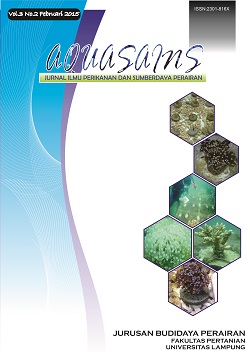Evaluasi Kualitas Sedimen Beberapa Tambak Udang Di Kabupaten Tulang Bawang Provinsi Lampung
Abstract
Pond bottom management play an important role in the success of shrimp culture. Study on the use of pond bottom pond as an indicator of shrimp pond productivity is still limitted. Shrimp culture has been developing in tulang Bawang Regency, Province of Lampung since early 1990. The waste produced by shrimp culture activity is possible to reduce pond bottom soil quality due to high organic compund and toxic material. The aim of this research was to evaluate the shrimp ponds bottom condition in Tulang Bawang Regency, Province of Lampung. This research was an explorative one. Data collection was done towards 12 shrimp pond units during water preparation period (pre-spreading) with the different locations of each pond from the watergate. The collected data of pond soil qualities were organic matter content, chlorophyll a, cation exchange capacity, oxidation-reduction potential, pH, and soil texture. The research results showed that soil qualities in shrimp ponds in Tulang Bawang Regency were still in range for shrimp culture. In generally, shrimp ponds in the area have soil textute of clay, sandy, and sandy clay.Chlorophyll a content, oxidation reduction potential (ORP) and organic carbon matter content were 21,5 μg/g, 76 mv and 1,26% in average respectively. Meanwhile cation exchange capacity and soil pH were 11,2 me/100g and 6,8 in average.
Downloads
Downloads
Published
How to Cite
Issue
Section
License
License for Authors
Authors who publish with this journal agree to the following terms:
- Authors retain copyright and grant the journal right of first publication with the work simultaneously licensed under a Creative Commons Attribution License that allows others to share the work with an acknowledgement of the work's authorship and initial publication in this journal.
- Authors are able to enter into separate, additional contractual arrangements for the non-exclusive distribution of the journal's published version of the work (e.g., post it to an institutional repository or publish it in a book), with an acknowledgement of its initial publication in this journal.
- When the article is accepted for publication, its copyright is transferred to Aquasains Journal. The copyright transfer convers the exclusive right to reproduce and distribute the article, including offprint, translation, photographic reproduction, microfilm, electronic material, (offline or online) or any other reproduction of similar nature.
- Authors are permitted and encouraged to post their work online (e.g., in institutional repositories or on their website) prior to and during the submission process, as it can lead to productive exchanges, as well as earlier and greater citation of published work (See The Effect of Open Access).
- The Author warrant that this article is original and that the author has full power to publish. The author sign for and accepts responsibility for releasing this material on behalf os any and all-author. If the article based on or part os student’s thesis, the student needs to sign as his/her agreement that his/her works is going published.
License for Regular Users
Other regular users who want to cite, distribute, remix, tweak, and build upon author’s works, even for commercial purposes, should acknowledge the work’s authorship and initial publication in this journal, licensed under a Creative Commons Attribution License.
This license lets others distribute, remix, tweak, and build upon your work, even commercially, as long as they credit you for the original creation.
This work is licensed under a Creative Commons Attribution 4.0 International License.Copyright Transfer Statement can be downloaded here


.png)









